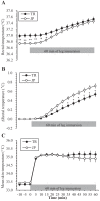Effects of duration of stay in temperate area on thermoregulatory responses to passive heat exposure in tropical south-east Asian males residing in Japan
- PMID: 22974339
- PMCID: PMC3514345
- DOI: 10.1186/1880-6805-31-25
Effects of duration of stay in temperate area on thermoregulatory responses to passive heat exposure in tropical south-east Asian males residing in Japan
Abstract
Background: In this study, we investigated the effects of duration of stay in a temperate area on the thermoregulatory responses to passive heat exposure of residents from tropical areas, particularly to clarify whether they would lose their heat tolerance during passive heat exposure through residence in a temperate country, Japan.
Methods: We enrolled 12 males (mean ± SE age 25.7 ± 1.3 years) from south-east Asian countries who had resided in Japan for a mean of 24.5 ± 5.04 months, and 12 Japanese males (age 24.1 ± 0.9 years). Passive heat exposure was induced through leg immersion in hot water (42°C) for 60 minutes under conditions of 28°C air temperature and 50% relative humidity.
Results: Compared with the Japanese group, the tropical group displayed a higher pre-exposure rectal temperature (P < 0.01) and a smaller increase in rectal temperature during 60 minutes of leg immersion (P = 0.03). Additionally, the tropical group showed a tendency towards a lower total sweat rate (P = 0.06) and lower local sweat rate on the forehead (P = 0.07). The tropical group also had a significantly longer sweating onset time on the upper back (P = 0.04) compared with the Japanese groups. The tropical group who stayed in Japan for > 23 months sweated earlier on the forehead and upper back than those who stayed in Japan < 11 months (P < 0.01 and P = 0.03 for the forehead and upper back, respectively). There was a positive correlation between duration of stay in Japan and total sweat rate (r = 0.58, P <0.05), and negative correlations between duration of stay and sweating onset time on the forehead (r = -0.73, P = 0.01) and on the upper back (r = -0.66, P = 0.02). Other physiological indices measured in this study did not show any difference between the subjects in the tropical group who had lived in Japan for a shorter time and those who had lived there for a longer time.
Conclusions: We conclude that the nature of heat acclimatization of the sweating responses to passive heat exposure that are acquired from long-term heat acclimatization is decayed by a stay in a temperate area, as shown by the subjects in our tropical group. We did not find any evidence of a decay in the other physiological indices, indicating that heat tolerance acquired from long-term heat acclimatization is not completely diminished through residence in a temperate area for less than 4 years, although some aspects of this heat tolerance may be decayed.
Figures




Similar articles
-
Comparison of thermoregulatory responses to heat between Malaysian and Japanese males during leg immersion.Int J Biometeorol. 2011 Jul;55(4):491-500. doi: 10.1007/s00484-010-0358-5. Epub 2010 Sep 8. Int J Biometeorol. 2011. PMID: 20824480
-
Cognitive performance during passive heat exposure in Japanese males and tropical Asian males from Southeast Asian living in Japan.J Physiol Anthropol. 2017 Jan 5;36(1):8. doi: 10.1186/s40101-016-0124-4. J Physiol Anthropol. 2017. PMID: 28057082 Free PMC article.
-
How humans adapt to hot climates learned from the recent research on tropical indigenes.J Physiol Anthropol. 2022 Jul 14;41(1):27. doi: 10.1186/s40101-022-00302-3. J Physiol Anthropol. 2022. PMID: 35836266 Free PMC article. Review.
-
Prolonged residence of temperate natives in the tropics produces a suppression of sweating.Pflugers Arch. 2006 Oct;453(1):67-72. doi: 10.1007/s00424-006-0098-x. Epub 2006 May 31. Pflugers Arch. 2006. PMID: 16736205
-
Effects of thermal stress during rest and exercise in the paediatric population.Sports Med. 1998 Apr;25(4):221-40. doi: 10.2165/00007256-199825040-00002. Sports Med. 1998. PMID: 9587181 Review.
Cited by
-
Differences in reported linguistic thermal sensation between Bangla and Japanese speakers.J Physiol Anthropol. 2017 Jun 5;36(1):23. doi: 10.1186/s40101-017-0139-5. J Physiol Anthropol. 2017. PMID: 28583194 Free PMC article.
-
Extreme Terrestrial Environments: Life in Thermal Stress and Hypoxia. A Narrative Review.Front Physiol. 2018 May 16;9:572. doi: 10.3389/fphys.2018.00572. eCollection 2018. Front Physiol. 2018. PMID: 29867589 Free PMC article. Review.
-
Preventing heat illness in the anticipated hot climate of the Tokyo 2020 Summer Olympic Games.Environ Health Prev Med. 2017 Sep 19;22(1):68. doi: 10.1186/s12199-017-0675-y. Environ Health Prev Med. 2017. PMID: 29165162 Free PMC article.
-
Visual information without thermal energy may induce thermoregulatory-like cardiovascular responses.J Physiol Anthropol. 2013 Dec 28;32(1):26. doi: 10.1186/1880-6805-32-26. J Physiol Anthropol. 2013. PMID: 24373765 Free PMC article.
-
A comparison of hydration effect on body fluid and temperature regulation between Malaysian and Japanese males exercising at mild dehydration in humid heat.J Physiol Anthropol. 2014 Feb 4;33(1):5. doi: 10.1186/1880-6805-33-5. J Physiol Anthropol. 2014. PMID: 24490869 Free PMC article.
References
-
- Nguyen MH, Rutkowska D, Tokura H. Field studies on circadian rhythms of core temperature in tropical inhabitants compared with those in European inhabitants. Biol Rhythm Res. 2001;32(5):547–556. doi: 10.1076/brhm.32.5.547.1291. - DOI
Publication types
MeSH terms
LinkOut - more resources
Full Text Sources

